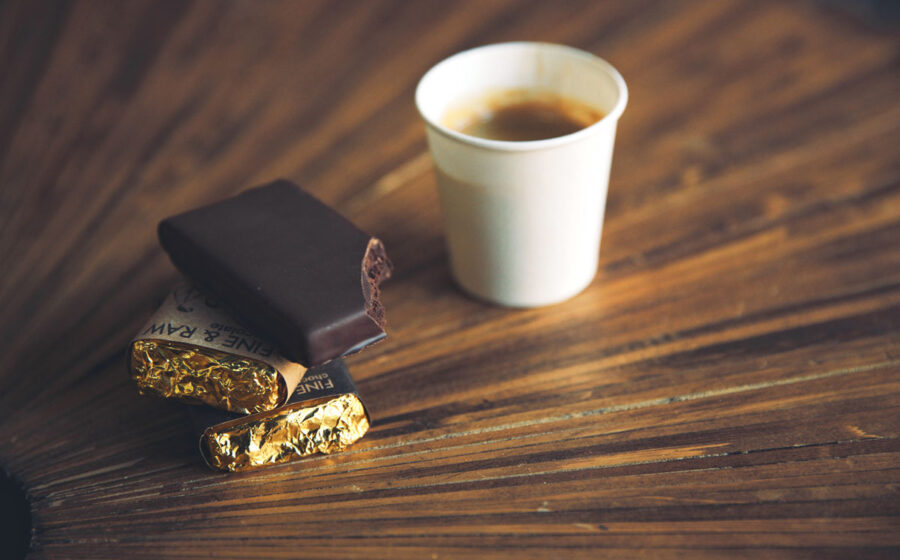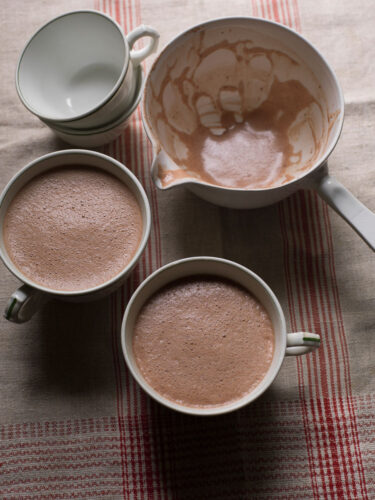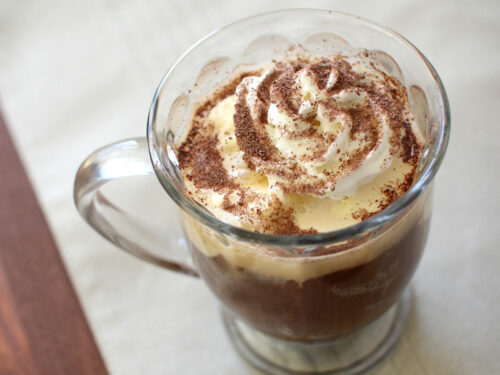Soon after I asked Alan Draper how using high-end, specialty chocolate has changed the mochas at 4A Coffee, he asked a regular customer for her take. The woman comes to 4A’s café in Brookline, Massachusetts, every day and orders a mocha. She’s probably thought more about the drink than Draper. After he questioned her, the woman didn’t say anything, and something about her manner made Alan worry he shouldn’t have either. Maybe she wasn’t happy to be known as a mocha addict.
A few hours later, a coworker of the woman arrived with a letter. The fussed look on the woman’s face hadn’t been annoyance: it resulted from a slew of thoughts trying to plow their way into consciousness.
In the note, she described the union of coffee and chocolate, the melding of the two into a better one. “There’s magic in each cup of mocha,” she wrote in what amounted to a crush note to her drink. Even a letter couldn’t communicate the joy she got from her daily mocha, and she broke into superlatives. “It’s perfection,” she wrote, “simple and earthy.”
A Standalone Ingredient
When it comes to adding other flavors to coffee, chocolate holds a rare position in cafés. Milk and sugar act as coffee’s salt and pepper, sometimes incorporated behind the bar but mostly set out for customers to add to taste. Other flavors, whether syrups or whole ingredients, are reserved for signature drinks, if used at all.
Chocolate floats between; not a staple but not a novelty. Think of it this way: besides milk, what other ingredient has its own coffee drink on every café’s menu? Usually, chocolate doesn’t get the attention and thought an ingredient in its position should. That’s changing.
For about a decade, cutting-edge chocolate producers have been sourcing specialty cocoa beans, sometimes in direct-trade models, and treating them lightly and thoughtfully—a development makers credit unreservedly to coffee. The chocolate in a mocha is being transformed into as many variations as the espressos it’s paired with.
Talking to makers about what makes great chocolate is similar to talking to roasters about coffee. Much of the effort in crafting the final product, the process of which begins much like coffee roasting, is about eliciting the best qualities from cocoa beans. Modern chocolate makers interpret that as not getting in the beans’ way. Before this current approach, chocolate makers, at least in the United States, roasted beans dark, and most of the flavors from the finished product reflected the darkness of the roast. Take a bite of an outstanding chocolate today, and you’ll taste the bean itself, which can present flavors as varied as red berries, lemon, and tobacco, just for starters.
Not Just Chocolate Syrup
Mochas made with these kinds of chocolate bring a lot more flavor than your typical sweet Hershey syrup. “It’s like you’re tasting almost a completely different drink,” says Lawren Askinosie, director of sales and marketing for Askinosie Chocolate, a company in Springfield, Missouri. “It’s that round, rich, full-bodied experience that a lot of people don’t realize they were missing until they try it.”
Among the major differences between stock syrups and fine chocolates is the lower sugar content. Draper from 4A uses Taza Chocolate, a company that creates rounds of chocolate that could be described as rustic if that phrase also meant decadent. “It’s like going back in time,” Draper says. “The bars take a lot to wrap your head around, but cut with milk, it allows people to appreciate it without needing to reconfigure their brains.”
Customers might need to alter their expectations, though. Taza’s chocolate doesn’t produce a sweet mocha. It creates a lot more.
Foremost is the bright and fruity notes that distinguish modern craft chocolates. All the chocolate makers interviewed for this article say these trumpet-blast flavors require a bit more thought regarding the pairing of chocolate and coffee.
Alex Whitmore, Taza’s owner, echoed several other chocolate makers when he said that pairing bright coffee with bright chocolate creates a lot of conflict in the cup. If a balanced marriage of flavors is the goal, and it usually is with mochas, Whitmore encourages deeper roasts or low-acidity coffees. Funnily, a perfect pairing for modern chocolate may be a coffee with a chocolaty profile.
But while a tender marriage of flavors might be best, the explosive tastes in these chocolates create a chance for a pyrotechnic flavor show. There is, after all, something to be said for a torrid love affair, even one that fails. Jamie Fey, a café manager for Dogwood Coffee in Minneapolis, says that many single-origin coffees open up in the presence of chocolate. Citric notes unfurl in ways they never do without the extra ingredient.
A Symphony of Flavors
To head toward culinary cloud cuckoo land, cafés can vary their chocolate choices. Like coffee, chocolate can be sold based on the country of origin of its cocoa beans, and some shops use different chocolate origins from the same company for different coffees. Scott Querry of Salt Lake’s Solstice Chocolate works with six coffeehouses. “I like the way [the different shops] choose a very specific origin of coffee and a very specific origin of chocolate,” he says. “I would think most places would say, ‘Oh, we like this single origin of yours, and it works well with our whole line.’ That’s not the case.”
Unlike coffee roasters, who tend to possess a purist streak, chocolate makers view their creations as ingredients as much as a great thing to be enjoyed alone. Because of this, most chocolate companies offer a range of chocolates and chocolate products for cafés to use in drinks. The most common are syrups, whole bars, and bulk broken bars. Some have shaved chocolate, and a few offer cocoa powder. Ghirardelli now offers an ultra-premium cocoa powder for cafés that want to stick with established brands.
Choosing which product to use depends on a shop’s needs and the products available from the company it partners with. Dogwood uses cocoa powder from Askinosie, adding espresso to the powder, whisking, then adding milk. Fey says the process is no more difficult than working with syrup or ganache. Blueprint Coffee in St. Louis had used the cocoa for syrup but has switched to broken bars to make ganache in their small kitchen.
Draper uses Taza’s shaved chocolate for his mochas, adding it straight to the cup. Whitmore likes this method but says it has a couple of problems. The first and biggest is that shaved chocolate can melt during shipping. This points to the benefit of working with a local chocolate company, which are appearing in more and more food-forward cities. The second problem, though maybe it’s better to call it a consideration, is that shaved chocolate has fatty cocoa butter, which will float in globules on top of the drink. Some customers might freak out at this, but plenty more are going to groove on the silky, rich mouthfeel the small amount of fat brings.
Taking On New Form
Chocolate bars or pieces can be melted and made into syrups, but they can quickly become solid because of the higher fat content. At Fine and Raw chocolate shop, which also serves specialty coffee, Daniel Sklaar melts his chocolate in a crock-pot on display. “When people see it—a pot full of chocolate that we ladle out—their eyes pop,” he says.
As more and more coffee customers develop increasingly sophisticated palates and a sense of adventure, great, bold-flavored chocolates are gaining a place near the grinders and tampers. The flavor potentials in mochas are blossoming, and a drink that coffee purists might dismiss can now be arguably more compelling and complex than a solitary coffee.
With such excellent flavor potential, the options may seem easy to get lost in. Sklaar advises café owners to take a fun-loving approach to bringing great chocolate to their menus. “When you’re dealing in such fantastic quality,” he says, “you just splash it around and have some fun.”
Cover photo courtesy of Fine and Raw
This story was originally published on November 24, 2014, and has been updated to meet Fresh Cup’s current editorial standards.

















